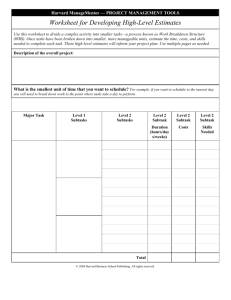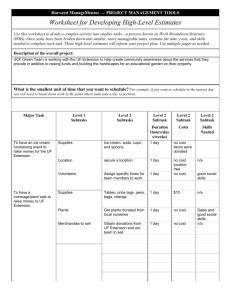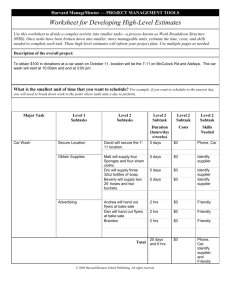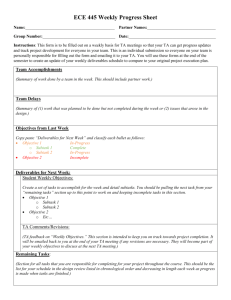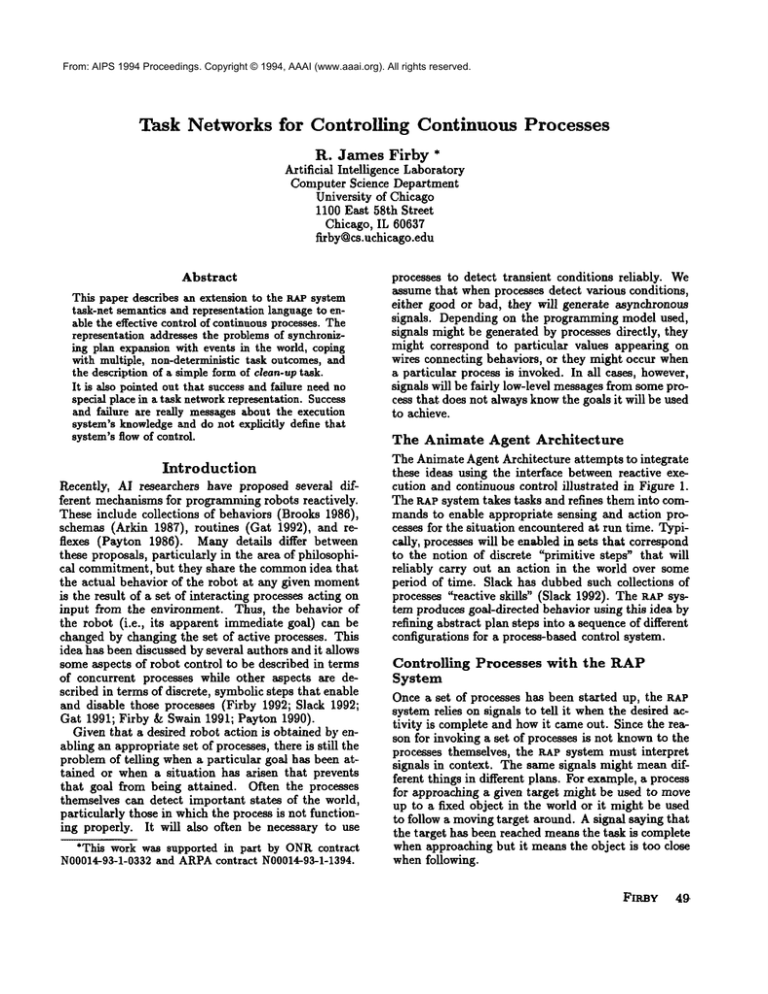
From: AIPS 1994 Proceedings. Copyright © 1994, AAAI (www.aaai.org). All rights reserved.
Task Networks for Controlling
Continuous Processes
R. James Firby *
Artificial Intelligence Laboratory
ComputerScience Department
University of Chicago
1100East 58th Street
Chicago, IL 60637
firby@cs.uchicago.edu
Abstract
This paper describes an extension to the RAPsystem
task-net semanticsandrepresentationlanguageto enable the effective controlof continuousprocesses.The
representationaddressesthe problemsof synchronizing plan expansionwith events in the world, coping
with multiple, non-deterministictask outcomes,and
the descriptionof a simpleformof clean-uptask.
It is also pointedout that successandfailure needno
special place in a task networkrepresentation.Success
and failure are really messagesabout the execution
system’sknowledge
and do not explicitly define that
system’sflowof control.
processes
todetect
transient
conditions
reliably.
We
assume
thatwhenprocesses
detect
various
conditions,
either
goodor bad,theywillgenerate
asynchronous
signals.
Depending
on theprogramming
modelused,
signals
might
begenerated
byprocesses
directly,
they
mightcorrespond
to particular
values
appearing
on
wires
connecting
behaviors,
ortheymight
occur
when
a particular
process
isinvoked.
Inallcases,
however,
signals
willbefairly
low-level
messages
fromsomeprocess
that.
does
notalways
know
thegoals
itwillbeused
toachieve.
The Animate Agent Architecture
The AnimateAgentArchitecture attempts to integrate
these ideas using the interface betweenreactive execution and continuouscontrol illustrated in Figure 1.
The RAP system takes tasks and refines theminto commandsto enable appropriate sensing and action processes for the situation encounteredat run time. Typically, processes
willbeenabled
insetsthatcorrespond
to thenotion
ofdiscrete
"primitive
steps"
thatwill
reliably
carryoutan action
in theworld
oversome
period
of time.
Slack
hasdubbed
suchcollections
of
processes "reactive skills" (Slack 1992). The RAPsystem produces
goal-directed
behavior
using
thisideaby
refining
abstract
plan
steps
intoa sequence
ofdifferent
configurations
fora process-based
control
system.
Introduction
Recently, AI researchers have proposed several different mechanismsfor programming
robots reactively.
These include collections of behaviors (Brooks 1986),
schemas (Arkin 1987), routines (Gat 1992), and
flexes (Payton 1986). Manydetails differ between
these proposals, particularly in the area of philosophical commitment,but they share the common
idea that
the actual behavior of the robot at any given moment
is the result of a set of interacting processesacting on
input from the environment. Thus, the behavior of
the robot (i.e., its apparent immediategoal) can
changedby changing the set of active processes. This
idea has been discussedby several authors andit allows
someaspects of robot control to be described in terms
Controlling
Processes with the RAP
of concurrent processes while other aspects are deSystem
scribed in terms of discrete, symbolicsteps that enable
Oncea set of processes has been started up, the RAP
anddisable
thoseprocesses
(Firby
1992;
Slack
1992;
systemrelies on signals to tell it whenthe desired acGat1991;Firby& Swain1991;Payton
1990).
tivity is completeand howit cameout. Since the reaGiven
thata desired
robot
action
isobtained
byenson for invokinga set of processes is not knownto the
abling
anappropriate
setofprocesses,
there
isstill
the
processes themselves, the RAPsystem must interpret
problem
oftelling
whena particular
goalhasbeenatsignals in context. The same signals might meandiftained
or whena situation
hasarisen
thatprevents ferent things in different plans. For example,a process
thatgoalfrombeingattained.
Oftentheprocesses forapproaching
a given
target
might
beusedto move
themselves
candetect
important
states
of theworld, up toa fixed
object
in theworld
orit might
beused
particularly
those
inwhich
theprocess
isnotfunction- tofollow
a moving
target
around.
A signal
saying
that
ingproperly.
Itwillalsooften
be necessary
touse
thetarget
hasbeenreached
means
thetaskiscomplete
butitmeans
theobject
is tooclose
*Thisworkwassupported
in partby ONRcontract whenapproaching
N00014-93-1-0332
andARPAcontract
N00014-93-1-1394.whenfollowing.
Filmy 49.
From: AIPS 1994 Proceedings. Copyright © 1994, AAAI (www.aaai.org). All rights reserved.
Tasks
RAPExecutor
World
Figure 1: The Animate Agent Architecture
Thus, a RAPtask description
must:
1. Allow concurrent threads of execution so that multiple control processes can be started up together.
2. Represent when to proceed to the next subtask in
a method given that the task must wait, for certain
signals to do so.
3. Describe methodsfor a task that allow different next.
steps whendifferent signals ~tre received.
This paper discusses these issues and presents a new
task method representation language for the RAP systeln.
The RAP System
The RAPsystem is designed for the reactive execution
of syxnbolic plans. A plan is assumed to include goMs,
or tasks, at a variety of different levels of abstraction
and the RAPsystem attempts to csrry out each task
in turn using different ,nethods in different situations
and dealing with comrnon problems and simple interr.ptions.
In the RAPsystem a task is described by a RAPwhich
is effectively a context sensitive program for carrying
out tim task. The RAP can also be thought of as describing a variety of plans for achieving the task in
different situation. For the purposes of this paper, the
important aspects of a RAPtask description are the
SUCCEED
and METtleD sections.
For example, the following RAPdescribes how to pick
something up in the simulated delivery world used in
initial RAPsystem development (Firby 1989: Firby
IIanks 1987):
(define-rap
(arm-pickup
?arm?thing)
(succeed
(ARM-HOLDING
?arm7thing))
(method
(context(not(TOOL-NEEDED
?thing?tooltrue)))
(task-net
(tl (arm-move-to ?arm ?thing) (for
(t2 (arm-grasp-thing ?arm ?thing))
50
REVIEWEDPAF ERS
(method
(context
(T00L-NEEDED
?thing?tooltrue))
(task-net
(tl (arm-pickup
?arm?tool)(for
(t2 (arm-move-to
?arm?thing)(for
(t3(arm-grasp-thing
?arm?thing)
))
’this RAP has two methods for achieving the goal.
The SUCCEED
clause is a predicate checked against
memoryto see if the overall task is complete. Each
MET’IIOD specifies a plan, or TASK-NET.
for achieving
the SUCCEED
condition in a given CONTEXT.
[,iko the
SUCCEEDclause,eachCONTEXTis a predicate
to be
checked
in memory.
Thispaperis aboutwriting
a’ASK.~,TSthatlinksubt.asks,
process
invocations,
andsignalinterpretation
intoa coherent
plans.
TheRAPsystem(Firby1987;1989)carries
outtasks
usingthefollowing
algorithm.
First,
a taskisselected
forexecution
andifit represents
a primitive
action,
it
is executed
directly,
otherwise
itscorresponding
RAP
is looked
qp in thelibrary.
Next.thatRAP’scheckfor
success
isusedasa queryto thesituation
dcscription
and,if satisfied,
thetaskis considered
complete
and
thenexttaskcanbe run.IIowever,
if thetaskhas
notyetbeensatisfied,
itsmethod-applicability
tests
arccheckedandoneof themethodswitha satisfied
testis selected.
Finally,
thesubtasks
of thechosen
methodarequeuedforexecution
iu placeof thetask
beingexecuted,
andthattaskis suspended
untilthe
chosenmethodis complete.
Whenall subtasks
in the
metimd hav,, been executed, the task is reactivated
and its completion test is checked again. If all went
well the completion condition will nowbc sat isfied and
execution can proceed to the next ta,sk. If not, method
selection is repeated anti another methodis attempted.
Task/Goal Semantics
An important
aspectof representing
andcxec,tinga
planis the meaningof a subgoalor subtask.The
RAP systemwasoriginally
writtenassuming
thatRAP
methodsubtasks
canbe treatedas atomic.Fromthe
pointof viewofthemethod
usinga subtask,
it willeithersucceed
orfail,andit willnotcomplete
untilthat
s.cccss orfailure is known.
Fail
¢
Approao.
T0rgo,
..-Soc0ood
(task-net
(t I (approach-target
?target)))
Figure 2: A Symbolic, Discrete Task
For example, the t,ask network shown in Figure 2
contains one suhtask and once that suhtask is spawned
by the interpreter, further processing of the method
From: AIPS 1994 Proceedings. Copyright © 1994, AAAI (www.aaai.org). All rights reserved.
will stop until the subtask completes. It is assumed
that the subtask will either succeed, in which case the
interpreter should continue processing the task network after the task (from the black dot in the figure)
or it will fail, in which case the method as a whole
should fail and all of its subtasks should be terminated
(in this examplethere aren’t any).
This representation and semantics for a subtask (or
method, or plan), assumes that it is appropriate to execute the next step in a method as soon as a subtask
completes. This assumption is pervasive in the literature and it makes perfect sense when subtasks are
truly atomic. In fact, one of the motivating ideas behind the RAPsystem is to try and make this property
hold by working on each task until it is knownto have
succeeded.
This semantics also embodies another, more subtle
assumption. It assumes that a subtask actually has
a well-defined finish and will knowwhen it has succeeded or failed. This assumption also makes sense
when actions are atomic. In fact, this assumption is
what makes actions primitive or atomic.
Continuous
Tasks and Signals
Unfortunately, given the low-level robot control system
used in the Animate Agent Architecture, neither of
these assumptions holds. Goals are achieved by sets
of processes that must be enabled independently and
detecting goal completion depends on the appropriate
interpretation of signals from those processes. Thus,
RAPmethods must explicitly define which signals mean
a subtask has succeeded and which signals mean it has
failed.
Whenrobot activity is controlled by enabling and
disabling sets of processes, time must pass while the
activity is underway. If the RAPsystem does the enabling and disabling explicitly, methods must have a
way to let time pass and synchronize further task expansion with process progress.
Wehave adopted a task net annotation that tells
the interpreter to WAIT-FOR
a given signal before proceeding to the next subtask in a method (this idea
is closely related to McDermott’s notion of blocking
a task thread while waiting for a fluent (McDermott
1992)). For example, a method to approach a fixed
target might look like that shownin Figure 3.
This method executes the subtask approach-target
and then waits for either an (at-target)
signal or
(stuck) signal. If the (at-target) signal is received
first, then this subtask succeeds and if (stuck) arrives first, this subtask fails and other subtasks in the
method are terminated.
The diagram shows WAIT-FOR clauses as gating conditions for letting the interpreter proceed with executing the method. The black dots correspond to the more
traditional interpretation of when the subtask has completed.
Fail (Terminate)
Stuck--~
¢] Approach
, F At Target
Target~Succeed
~ (Proceed)
(task-net
(tl (approach-target ?target)
(salt-for (at-target)
:proceed)
(wait-for (stuck) :terminate)))
Figure 3: Waiting for A Signal to Proceed
Concurrent
Tasks
The RAPtask net representation has always supported
non-linear methodswith parallel threads of execution.
This ability to support concurrent tasks is critical when
the RAPsystem is being used to enable and disable
processes in concurrent sets. For example, consider
the method shown in Figure 4.
Fail (Terminate)
Stuck--~
Approach
.FAt
Target
Target
~ Succeed
(Proceed)
Track Target
Lost Target---~
Camera Problem--~ V
Fail (Terminate)
(task-net
(tl (approach-target ?target)
(wait-for (at-target)
:proceed)
(wait-for (stuck) :terminate))
(t2 (track-target ?target)
(wait-for (lost-target) :terminate)
(wait-for
(camera-problem)
:terminate)
(until-end
tl)))
Figure 4: A Simple Concurrent Task Net
Both of the primitive processes approach-target
and track-target must be active to get the robot to
visually servo to a selected fixed object. The task net
does not order these tasks and the interpreter follows
two threads of execution. Choosing one thread to follow first, the interpreter starts the indicated process
and then blocks that thread until receipt of one of the
indicated signals. While that thread is blocked, the interpreter follows the other thread, enabling the other
process and blocking that thread while waiting for one
of its signals. The until-end annotation in the task
FIKBY 51
From: AIPS 1994 Proceedings. Copyright © 1994, AAAI (www.aaai.org). All rights reserved.
nettellstheinterpreter
thatsubtask
t2 should
beterminatedwhenever
subtasktl completes.
Theonlyway
thismethodcancomplete
successfully
is to receive
the
I
(at-target)
signalfromprocessapproach-target.
Thecritical
stepin concurrent
RAP taskprocessingwhenprimitive
actions
startprocesses
rather
than
achieve
goalsis notgetting
concurrent
taskexpansion
to work,butrather,
stopping
expansion
in the right
placesto synchronize
further
processing
withtheactualprogress
of thetaskin therealworld.Thissynchronization
is achieved
usingWAIT-FOR
clauses.
The ability of a plan representation formalism to explicitly allow both concurrency and synchronizing execution with events in the world is crucial if the plans
are to be used to control a real-time system made up
of composable, concurrent processes.
Success
and Failure:
Red Herrings
Another deeply ingrained assumption in task representation is that a given task will have only two outcomes:
success or failure. Tile original RAP system again tried
to enforce this assumption by giving each task a success clause that must be satisfied before it stops trying various methods to achieve its goal. However, as
has already been illustrated in Section , it isn’t very
meaningful to say that a task to enable a control process succeeds. Such tasks will invariably succeed by
starting the process in motion. What matters are the
signals that are generated by the process while it is
running. Somesignals will mean success and some will
mean failure. Hence, WAIT-FOR
annotations include
the appropriate outcome to use for the task as a wholc
whenthe signal is received.
ltowcver, grouping the initiating of a process and its
termination signals (both good and bad) into a logical
unit using WAIT-FOR
clauses is too limiting. In fact.
the whole idea of success and failure is too limiting.
The Problem
of Cleanup
Tasks
Consider the problem of local cleanup tasks. When
an activity requires enabling a variety of processes and
then waiting for some event in the world, forcing the
mcthoddefining the activity to either succeed or fail o,l
the event makesit very difficult to cncodc steps in the
method to "clean up" the situation when a failure occurs. For example, let’s assume that the track-target
process used previously requires that the robot’s camera be turned on first. It is a simple matter to include
a task that comes before the track-target
task to
turn the camera on, but where should thc corresponding task to turn the camera off go? Placing it after
receipt of the (at-target) signal makes sense if everything works out. IIowever, if the target is lost and
1Don’t worry about the arguments to approach-target
and track-target. In reality processes like these must
knowhowto exchangetarget information in real time below
the level of the RAP system.
52
REVIEWED PAPERS
the (lost-target) signal is received, the method will
fail and terminate before ever reaching the task to turn
the camera off.
Forcing the interpretation of signals as success and
failure prevents coding methods that include actions
to be taken regardless of what happens. In the RAP
system, and most other planning systems in the literature, when a subtask fails, all other subtasks in the
same method are assumed no longer valid and terminated.
The problem of cleanup tasks is well known in the
literature (Gat 1991; McDermott 1991) and the natural inclination is to start trying to represent explicit
cleanup or failure recovery plans. However, a closer
look at the problem shows that the whole idea of success, failure, and recovery is a red-herring. The real
problem is that tasks have multiple outcomes. The
track-target task doesn’t succeed or fail, it might
continue to track, it. might lose the target, it might
suggest a better tracking method, the camera might
fail, or a whole host of other possibilities.
Each of
these outcomes may require a different interpretation
2and a different course of action.
Non-Deterministic
Task Networks
What we really need is a task net representation that
explicitly recognizes when subtasks have multiple outcomes and allows a different thread to be followed for
each one. Given such a representation,
success and
failure are possible outcomes, like signals, that can be
used to change the flow of control. Success and failure
in themselves mean nothing.
This idea is incorporated into RAPtask nets using
the WAr,’-FORclause introduced above. As already
hinted at in the examples, the third argument can be
: proceed or : terminate or the tag of the next task to
execute when the signal occurs. Consider the method
defined by the task net show,l in Figure 5.
In this method, each WAIT-FOR
clause points to the
next subtask to execute upon receipt of the appropriate signal. Notice that :success is treated as a signal instead of a result. The RAPsystem also uses the
FORclause to specify the next step in a plan which,
given the semantics of success as a signal, is really just
a short form for (wait-for :success t6s/¢). Thc
UNTIL-START
annotation is similar to UNTIL-END,
specifying that both task tl and t2 should terminate when
task t3 starts. Thus, if either 1;1 or t2 completes and
apasses control to t3, the other will stop.
2This mechanismonly ax:counts for a very simple type
of cleamlp task. The problem of cleaning up a situation
before dealing with an interruption is muchmoredifficult.
One approach is to use POLICY
and PROTECTION
triggered
tasks as suggested by McDermott(McDermott1992) but
the general problemrequires makingcomplextradeoffs betweencourses of action at runtime.
~Don:t worry about the fact that not turning
off the camera but terminating the method on a
From: AIPS 1994 Proceedings. Copyright © 1994, AAAI (www.aaai.org). All rights reserved.
Stuck
At Target
.
camera
I,/
J Approach
/].
T~get
[~
I~:A
Camerak
CameraProblem’---"
(task-net
(tO (camera-on) (wait-for :success tl) (for
(tl (approach-target ?target)
(wait-for (at-target)
(wait-for (stuck) t3)
(until-start
t3))
?target)
(t2 (track-target
(wait-for (lost-target)
(eait-for (camera-problem) :terminate)
(until-start
t3))
(t3 (camera-off)))
Figure 5: A Complex Task Net
It is also important to note that there is no longer
any notion of failure. Should the (camera-problem)
signal be received while task t2 is active, the method
as a whole is terminated; terminating all of its active
subtasks. The previous semantics given to task failure
is subsumedby an explicit directive to terminate the
method. Of course, it is possible to use :fail as a
signal to be caught from the subtask so that if it explicitly fails, control can be passed to an appropriate
followup subtask. By default, all subtasks are assumed
to have an implicit (wait-for
:fail :terminate)
annotation unless an explicit WAIT-FOR
failure is included. This default assumption leaves previous RAP
task nets with their original semantics.
Related
Work
The Reactive Plan Language proposed by Mcdermott
is particularly relevant to the issues addressed in this
paper (McDermott 1991). The RPL system includes
mechanismsfor makingtasks wait until particular signals arrive and for multiple threads of plan execution.
A goal of that work is to define a language and interpreter that allows plans for arbitrary processes so that
the same language used to describe tasks and plans can
be used to describe low-level feedback loops aa well.
With the addition of signals and multiple outcomes,
the similarity between RAPtask networks and finite
state automata becomes more compelling. RAP task
networks don’t explicitly describe finite state automata
(camera-problem) signal makes no sense. This example
is intended simplyto illustrate the ideas.
because tasks don’t correspond directly to states of
execution but the similarity suggests connections to
control theory and work that attempts to bridge the
gap between AI and control theory. In partic’ular, subsumption based robots use behaviors described by finite state automata (Brooks 1986) and the CIRCAsystem reasons about plans as finite state automata to
construct provably safe control loops (Musliner, Durfee, & Shin 1993).
Discrete event system theory is directed toward
building and understanding control plans for systems
that can be described as finite state automata (Kamadge & Wonham1987). These ideas have been used
to build simple control systems for vision-based robot
navigation problems (Kosecka & Bajcsy 1993). The
Animate Agent project uses aa underlying control system that can be reconfigured into different states, and
RAPtask networks are plans for sequencing those states
in response to changing goals and events. Thus, in
some sense, RAPtask networks are control plans for a
discrete event system. Currently, RAPtask networks
axe intended to cover a broad range of behavior but do
not attempt to guarantee controllability or stability
over all task goals. Wewill be exploring tighter connections between the RAPsystem and discrete event
control theory in the future.
Conclusions
The symbolic planning notion of primitive, atomic actions cannot readily be used to control the enabling
and disabling of processes that must act together over
time to achieve goals in the world. Whenprimitive actions start processes in motion and the same processes
can be used in different combinationsto achieve different goals, the planning system can no longer assume
that primitive actions will have their ownwell-defined
end points.
This paper proposes an extension to the RAPsystem task-net representation and semantics to enable
the effective control of such continuous processes. In
particular:
¯ The RAPtask net’s ability to represent concurrent subtasks can be used to enable many subtasks/processes simultaneously.
This allows a
methodto individually enable all of the processes required to carry out a particular activity in the world.
¯ RAPtask nets are extended to include WAIT-FOR
clauses between plan steps. A WAIT-FOR
clause specifies a condition that must be tru.e in the world before the interpreter can move on to the next task
in the method. This allows the expansion/execution
of subtasks to be synchronized with events in the
world. Synchronization was previously assumed to
be inherent in the success of primitive actions.
¯ The WAIT-FOR
clause is also used to allow different
threads of execution to proceed from different task
outcomes. Effectively, each WAIT-FOR
represents a
FIRBY 53
From: AIPS 1994 Proceedings. Copyright © 1994, AAAI (www.aaai.org). All rights reserved.
different possible task outcome and can specify the
next subtask to execute after the WAIT-FORs
condition becomes true.
This task network representation
has been implemented and is being used to control a real robot doing vision-based navigation tasks at the University of
Chicago.
This pap(:r also argues that success and failure have
no special place in a task network representation. Success and failure arc interpretations placed oil certain
task outcomes based on what is desired. In fact, the
RAt’ system already has little use for explicit failure.
Whether a RAPmethod succeeds or fails, the task using the method does not succeed unless its explicit
success condition is true. Method success is simply
method completion and method failure means that all
subtasks in the method should be terminated. With
the explicit representation of multiple outcorncs for a
subtask, and the ability for an outcome to explicitly
terminate a method, failure and success are no long,:r
necessary.
The notion of a failure still exists in the RaP system
but it means exclusively that the system does not know
hen, to achieve the task. The only way a task can fail is
if all of its methodshave been tried rcpeatcdly and its
siJccess condition has not been met: either no method
applies in the current situation or applicable melhods
appear to have no usefifl effect on the world. Thus,
failure is a signal about the planning knowledgeof the
system and not about the execution result of a task.
Acknowledgements
Manyof these ideas were’ madeclear during very int,’resting discussions with Marc Slack and Tim Converse.
References
Arkin: R.. C.. 1987. Motor sehenm based navigation
for a mobile robot: An approach to i~rogramming by
belaavior. In International Conference on Robotics
and Automation. Raleigh, NC: IEi"E.
Brooks, R. A. 1986. A robust layered control system
for a mobile robot. IF.RE Journal of Robotics and
Automation RA-2(I).
Firby, R. ,I., and Ilanks, S. 1987. A simulator for
mobile robot planning. In Knowledge-BasedPlan.aing
Workshop. Austin, TX: DARPA.
Firby, R,. J., and Swain. M. J. 1991. Flexible taskspecific control using active vision. In Sensor Fusion
IV: Control Paradigmsand Data ,qtrucluT~.s. Boston,
MA: SPIE.
Firby, R,. J. 1987. Aninvestigation into reactive planning in complex domains. In 5’ixth National Conference on Artificial Intelligence. Seattle, WA:AAAI.
Firby, R,. J. 1989. Adaptive execution in complex
dynamic worlds. Technical Report YALEU/C,SI)/RR
#672, Computer Science Department, Yale University.
54
REVIEWED
PA PEILS
Firby, R. J. 1992. Building symbolic primitiw~s with
continuous control routines. In First International
Conference on A [ Planning Systems.
Gat, E. 1991. Reliable Goal-Directed Reactive Control
of Autonomous Mobile Robots. Ph.D. Dissertation,
C.omputer Science and Applications, Virginia Polytechnic Institute.
Gat, E. 1992. Integrating planning and reacting in
a heterogeneous asynchronous architecture for controlling real-world mobile robots. In Tenth National
Conference on Artificial Intelligence. Saal Jose, C,A:
AAAI.
Kosecka, J., and Bajc.sy, R. 1993. Cooperation of
visually guided behaviors. In ~burth International
Conference on Compu/er Vision. Berlin, Germany:
[EEE.
McDermott,D. 1991. A reactiw. ~ plan language. Technical Report YALEU/CSI)/RR~864, Yale Uniw~rsity Department of Computer Science.
1992. Transformational
planMcl)ermott, I).
rfing of reactive
bPhavior.
Technical Report
YALEU/C, SD/RR ~9dl, Yale University Department of Computer Science.
Musliner. D. J.: Durfee, E. ll.; and Shin, K. G. 1993.
Circa: A cooperative intelligent real-time control architecture. IEl’;h: Transactions on Systems. Man. and
Cybernetics 23(6).
Payton, D. 1986. An architecture for reflexive autonomous vehicle control. In International Conferencc on Robotics and Aulomation. San Francisco. CA:
IEEE.
Payton, D. 1990. Exploiting plans ~us resources for
action. In Workshop on Innovative Approaches to
Planning. Scheduling, and Control. San Diego, CA:
DARPA.
Ramadge. P. J., and Wonham. W. M. 1987. Supervisory control of a clt~ss of discrete event processes.
SIAMJournal on Control and Optimization 25(1).
Slack, M. 1992. Sequencing formally defined reactions
for robotic activity: Integrating raps and gapps. In
Vol. 1828 Sensor Fusion V: Simple Sensing for Complcz" Action. Boston, MA:SPIE.

